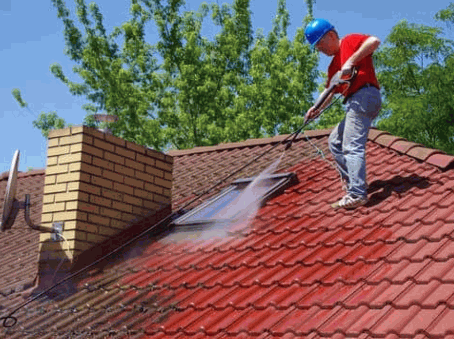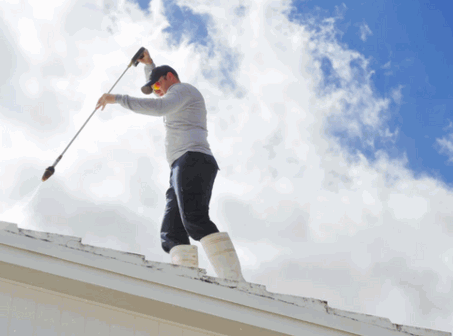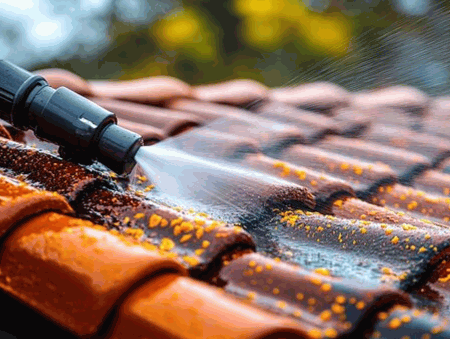Cleaning roof tiles prior to painting is an essential procedure that can greatly influence the durability and aesthetic quality of your roof tiles and roofing materials. A comprehensive cleaning process facilitates improved paint adhesion, extends the lifespan of the roof paint application, and ultimately enhances the overall curb appeal of your home exterior. This article provides an in-depth examination of the necessary materials for the cleaning process, detailed step-by-step instructions for effective roof tile cleaning, practical tips for achieving optimal results, and the advantages of maintaining clean tiles before applying a new coat of roof tile paint. Prepare to enhance the quality of your roofing project with effective roof maintenance strategies.

Contents
Cleaning roof tiles prior to painting is essential for ensuring both the longevity and effectiveness of the paint application. Thorough cleaning eliminates dirt, moss, and other debris that could hinder the proper adhesion of the paint, which may result in issues such as peeling and discolouration.
Furthermore, a clean surface allows any protective coatings applied subsequently to function optimally against adverse weather conditions, thereby enhancing the roof’s durability. This maintenance procedure not only enhances the aesthetic appeal of the roofing materials but also contributes significantly to the overall integrity of the home's exterior.
Ultimately, this proactive approach can lead to reduced energy costs and an extended lifespan for the roof.
Learn about: What Are The Types Of Roofs

To properly clean roof tiles prior to painting, it is necessary to gather several essential materials that will facilitate a thorough and safe cleaning procedure, including roof tile repair solutions. A pressure washer is a critical tool for effectively removing stubborn contaminants.
Additionally, a specially formulated cleaning solution, such as Fungicidal Wash, is recommended to eliminate the moss and algae that may have accumulated over time. Furthermore, a scrubbing brush should be utilised to address any residual dirt.
It is also crucial to wear appropriate safety gear, including gloves and goggles, to ensure personal protection during the cleaning process.
A pressure washer is a vital tool for efficiently cleaning roof tiles, as it delivers the power necessary to eliminate dirt, debris, and algae from various roofing materials.
Using a pressure washer enables homeowners to tackle some of the most stubborn stains that accumulate over time, including mould and mildew. These stains not only diminish the aesthetic appeal of the home but can also lead to structural damage if left untreated. Furthermore, the capability of the pressure washer to reach elevated areas simplifies the process of cleaning steep or tall roofs, enhancing both safety and effectiveness.
Additionally, selecting the appropriate pressure settings is essential. Different types of roof tiles, such as concrete, clay, or asphalt shingles, may require varying levels of pressure to prevent damage while ensuring a thorough cleaning.
For example:
By understanding these specifications, individuals can preserve the integrity of their roofs while taking advantage of the enhanced cleaning capabilities that a pressure washer offers, thereby facilitating optimal roof maintenance.

Utilising a specialised cleaning solution, such as Fungicidal Wash, is essential for the maintenance of roof tiles, as it effectively targets specific contaminants, including moss and algae, which can compromise protective coatings.
Along with fungicidal solutions, various other cleaning products are available that cater to the distinct needs of different roof tile types, each demonstrating unique efficacy. For example, a bleach solution can be highly effective on concrete tiles, as it aids in breaking down stubborn stains and preventing future growth. Conversely, acid-based cleaners may be more appropriate for metal roofs, as they efficiently remove rust and mineral deposits. It is imperative to consider the composition of the roof tiles when selecting these cleaning agents.
Proper preparation of the areas not only enhances the effectiveness of the painting process but also contributes to the long-term integrity of the roof.
By adopting an appropriate cleaning method, homeowners can significantly extend the lifespan of their roofs, thereby optimally preparing surfaces for future treatments, such as roof paint application and painting.
A scrubbing brush is an essential tool for cleaning roof tiles, particularly in areas where a pressure washer may not effectively reach or in the case of stubborn stains that necessitate manual intervention for roof tile cleaning. Its proper use is critical for maintaining the longevity and appearance of roofing materials. Utilising these brushes not only aids in the removal of debris but also prevents potential damage caused by accumulated grime and mould.
To achieve optimal results, it is imperative to select the appropriate type of scrubbing brush tailored to the specific roofing material, whether it be asphalt shingles, tiles, or metal roofs. Each type of brush serves a distinct purpose in ensuring a comprehensive clean that safeguards structural integrity and enhances aesthetic appeal.
When evaluating types of scrubbing brushes for roof cleaning, several options are particularly noteworthy:
Incorporating these scrubbing brushes into a cleaning regimen complements the use of specialised cleaning solutions that target specific stains, further improving roof aesthetics. Techniques such as applying a cleaning solution and allowing it to sit for a few minutes before scrubbing can significantly enhance overall effectiveness.
By employing the appropriate scrubbing brush in conjunction with effective materials and techniques, homeowners can ensure that their roofs are not only clean but also well-maintained, thereby prolonging their lifespan and enhancing property value.

Safety equipment is essential when cleaning roof tiles, as it serves to protect individuals from potential hazards associated with working at heights and handling cleaning chemicals.
When undertaking such tasks, it is imperative to utilise appropriate safety equipment to mitigate risks and ensure an effective cleaning process. The primary components of safety equipment include:
By prioritising these protective items, individuals engaged in roof maintenance can substantially reduce the likelihood of accidents and injuries, thereby fostering a safer work environment.

Cleaning roof tiles prior to painting requires a systematic approach that ensures both a clean surface and optimal conditions for paint adhesion. The initial step involves preparing the area by implementing necessary safety measures.
Subsequently, a suitable cleaning solution should be mixed and applied evenly across the tiles, allowing it to penetrate and effectively break down dirt and contaminants. After scrubbing the tiles, it is essential to thoroughly rinse them to remove any residual debris before proceeding with the painting process.
This meticulous preparation will enhance the roof's aesthetics and durability.
Preparing the area is a critical first step in the process of cleaning roof tiles, ensuring that both the workspace and the surrounding environment are safe and well-organised.
Before commencing any cleaning project, it is essential to conduct a thorough inspection of the workspace. Clearing the area of obstacles not only streamlines the cleaning process but also significantly reduces the risk of accidents.
Implementing appropriate safety equipment is paramount, as it adds a vital layer of protection for all individuals involved in the task. This may include items such as goggles, gloves, and harnesses, depending on the specific requirements of the job. Furthermore, it is crucial to protect nearby plants or structures from harsh cleaning solutions, which can cause damage or harm vegetation, especially during roof refurbishment.
To achieve this, the following measures should be considered:
By taking these precautionary steps, one not only safeguards the immediate environment but also promotes a responsible approach to maintaining a clean and aesthetically pleasing roof, essential for roof aesthetics improvement.
Properly mixing the cleaning solution is essential for effective roof maintenance, particularly when using products such as Fungicidal Wash, available at PaintOutlet, to address issues related to moss and algae.
To achieve optimal results, it is imperative to measure the ingredients with precision. Begin by selecting the appropriate concentration based on the specific type of roof tile material—whether it is clay, concrete, ceramic, or slate—since each material necessitates a distinct approach.
Before application, it is crucial to wear protective gloves and eyewear and to ensure adequate ventilation to mitigate the risk of inhaling fumes. Additionally, it is prudent to test the mixture on a small, inconspicuous area to evaluate its effect before proceeding with the full application, as this precaution helps to avoid potential damage to the roof material, especially when planning to paint roof tiles.
Applying the cleaning solution uniformly across the roof tiles is crucial for optimising its effectiveness in removing dirt and preparing the surface for painting, as part of overall roof repair solutions.
To achieve this, it is advisable to utilise appropriate tools such as a wide-bristle brush or a sprayer, which facilitates an even distribution of the cleaning solution. Applying the solution in sections can prevent oversaturation and enhance control during the cleaning process, crucial for roof coatings application.
This essential waiting period may appear tedious; however, it significantly contributes to achieving a clean substrate that is ready for the subsequent painting steps, including the application of acrylic paint. Thorough rinsing with water afterward ensures that no residual cleaning solution interferes with the adhesion of the painting materials.

Scrubbing the tiles after the application of the cleaning solution is an essential step, as it aids in the removal of stubborn dirt and contaminants that the solution may not eliminate on its own. Proper scrubbing techniques can significantly enhance cleaning efficiency, ensuring a pristine finish that contributes to overall roof weatherproofing.
To achieve optimal cleanliness, utilising the appropriate tools is critical. The following are recommended brushes and techniques:
Different tile types necessitate distinct approaches. For instance:
| Tile Type | Recommended Action |
|---|---|
| Ceramic | Gentle scrubbing with a soft brush |
| Porcelain | Stiff brush with firm pressure |
| Natural Stone | Use a pH-neutral cleaner with a soft brush |
Incorporating thorough scrubbing into the cleaning process not only enhances the appearance of tiles but also extends their longevity, making it a critical practice for maintaining a clean and healthy environment, integral to the roofing industry.

Rinsing the tiles thoroughly constitutes the final step in the cleaning process, ensuring the complete removal of all cleaning solutions and debris, thereby providing a clean surface for painting and roof insulation.
To achieve optimal results during the rinsing process, it is imperative to utilise clean water, as it is essential for eliminating any residues that may compromise the finish. The rinse water must be free from contaminants to prevent the introduction of new impurities onto the surface, ensuring the efficacy of roof coatings.
In all scenarios, adopting a top-down approach is considered best practice, as it ensures that water and debris flow downwards, preventing any accumulation in previously cleaned areas. By adhering to these methods, one can ensure a pristine surface, is adequately prepared for subsequent stages of maintenance or restoration.

Effective cleaning of roof tiles requires adherence to several best practices to ensure efficiency and safety, thereby enhancing overall roof maintenance and supporting efforts in roof refurbishment.
It is advisable to begin the cleaning process at the top of the roof and work downwards, preventing dirt and debris from contaminating already cleaned areas.
When using a pressure washer, it is essential to apply the appropriate pressure settings and remain vigilant regarding surrounding plants and objects to prevent any potential damage during the cleaning process, especially when roof weatherproofing.
Starting from the top when cleaning roof tiles is a highly effective strategy that mitigates the risk of recontamination in areas that have already been cleaned.
This systematic approach not only enhances efficiency but also ensures thoroughness throughout the cleaning process. By addressing the highest points first, any debris or contaminants can flow downwards, facilitating a comprehensive cleaning and preparation for roof painting.
Implementing this technique minimises the likelihood of overlooked spots and promotes a thorough cleanse, which is essential for maintaining the integrity of roofing materials. Regular maintenance utilising this method fosters the longevity and durability of the roof, safeguarding it against potential damage that may result from neglect.
A meticulously cleaned roof can significantly enhance the overall appearance of the home and increase its market value. Moreover, it can contribute to reducing energy bills by improving roof insulation.
Homeowners can also realise savings on potentially costly repairs by adopting a well-organised cleaning schedule, thereby underscoring the importance of this cleaning strategy within the broader context of roof maintenance and roof repair solutions.
Utilising the appropriate pressure when operating a pressure washer is crucial to effectively clean roof tiles without inflicting damage. Setting the correct pressure not only safeguards the integrity of the tile but also enhances the overall efficacy of the cleaning process, making it essential for individuals engaged in roof maintenance. It is important to adjust the pressure according to the specific type of roof tile—whether clay, asphalt, metal tiles, or concrete—as this can significantly impact the results achieved and help prevent potential complications.
For instance, higher pressure settings may be suitable for more durable materials, while softer tiles necessitate a gentler approach to prevent erosion or cracking. Additionally, environmental factors must be considered, as inadequately cleaned surfaces may accumulate debris, leading to further issues.
Striking a balance between cleanliness and safety is paramount, particularly when utilising high-powered equipment. The following pressure settings are generally recommended, especially when considering roof refurbishment:
Ensuring the right balance mitigates the risk of injury or damage to the property. Implementing appropriate techniques, such as maintaining a safe distance and employing even strokes, further enhances the cleaning process while preserving the longevity of the roof and ensuring the effectiveness of roof coatings.
Being attentive to the surrounding plants, objects, and weather elements during the cleaning process is essential for preventing unintended damage and maintaining the effectiveness of cleaning efforts.
To achieve this, it is advisable to implement several protective measures that effectively safeguard valuable items and greenery from harsh cleaning agents and physical harm. Utilising tarps is an excellent strategy; laying them over delicate plants or items susceptible to damage from spills or debris serves as a temporary shield, preserving their condition while also creating a cleaner workspace. When operating in sensitive environments, adopting less aggressive cleaning methods is recommended. For instance, instead of employing strong chemicals, one should consider eco-friendly alternatives that minimise risks.
By prioritising these considerations, individuals can ensure a cleaner environment while effectively safeguarding their valuable possessions.

The frequency of cleaning roof tiles is primarily determined by the type of roofing materials employed, such as ceramic roof tiles, and the local weather conditions to which they are exposed, as these factors can influence the accumulation of dirt and algae. It is generally recommended to clean roof tiles at least once a year; however, this guideline may vary depending on specific environmental conditions and the particular roofing materials used, such as clay tiles or bitumen shingles, each of which may necessitate distinct maintenance schedules.

Cleaning roof tiles prior to painting provides several advantages, including enhanced adhesion of the paint, prolonged durability of the results, and improved aesthetic appeal of the roof. Applying a primer before painting can further enhance these benefits.
A clean surface facilitates effective bonding of the paint, thereby minimising the risk of peeling or discolouration over time. Furthermore, maintaining clean roof tiles contributes to the overall appearance of the home and can increase its market value. Roof tile coatings are also an essential part of this process.
Achieving improved adhesion of paint on roof tiles is one of the primary advantages of performing a thorough clean prior to application, as a clean surface facilitates optimal bonding.
During the surface preparation process, it is essential to eliminate any contaminants such as dirt, moss, or mildew, which may impede the paint's ability to adhere effectively. Proper cleaning not only enhances the aesthetic appeal but also plays a critical role in prolonging the lifespan of the applied coatings. Using products like Paintmaster or PaintOutlet can also improve the final results.
A well-prepared surface ensures that the paint can penetrate effectively and adhere securely, thereby reducing the potential for peeling or flaking over time. Neglecting this crucial step may result in significant issues, including problems in DIY projects:
Consequently, the importance of thoroughly cleaning roof tiles cannot be overstated; it greatly enhances overall paint adhesion and safeguards the investment made in property maintenance.
One of the significant advantages of cleaning roof tiles prior to painting is the achievement of longer-lasting results, as this practice minimises the likelihood of premature wear and tear.
A comprehensive cleaning process not only prepares the surface for improved paint adhesion but also removes any debris, algae, or mould, thereby preventing future growth that could compromise the integrity of the paint. When roof tiles are thoroughly cleaned, the paint can establish a solid bond, enhancing its capacity to endure various environmental factors, including heavy rainfall, intense sunlight, and fluctuating temperatures.
This proactive approach to roof maintenance can substantially extend the longevity of the paint job, ultimately resulting in fewer required touch-ups and a reduction in overall maintenance costs.
The impact of environmental factors includes:
By effectively addressing these considerations through proper cleaning, homeowners can ensure that their roofs not only possess aesthetic appeal but also maintain durability against nature's unpredictable elements.
Improving kerb appeal is a significant advantage of cleaning roof tiles prior to painting, as a pristine roof contributes to the overall aesthetics of the home.
When homeowners prioritise cleanliness, they foster an inviting first impression that captures the attention of both passers-by and potential buyers. Well-maintained roof tiles not only demonstrate meticulous attention to detail but also indicate a commitment to the overall upkeep of the property. This can lead to:
In conclusion, the condition of roof tiles significantly influences the transformation of an ordinary facade into an extraordinary masterpiece, thereby impacting the overall perception of the property. For the best results, consider using Polycote roof products to ensure quality and durability.
